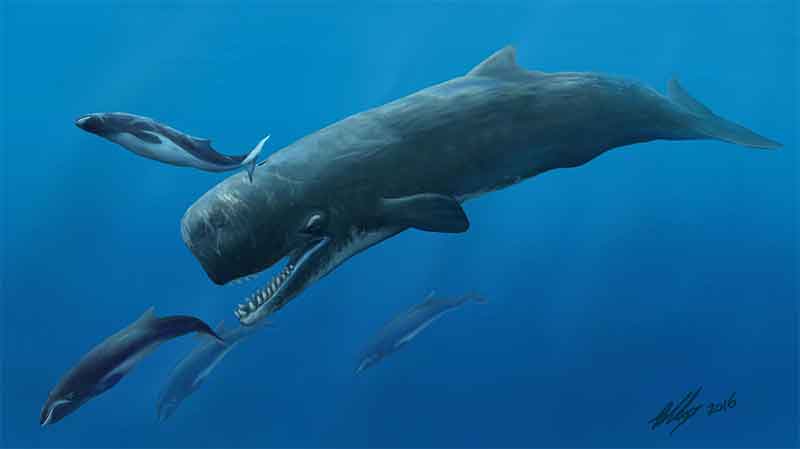
The sperm whale is extreme. They have the largest brains and the largest noses on Earth. The sperm whale’s nose is a huge and sophisticated sonar device that produces the most powerful sounds of any animal––and we’re only just starting to understand their communication methods and the spectacular complexity of their modes of life.
The facts about sperm whales rival in some ways the extreme capacities and behaviors that until recently we thought were uniquely human.
The sperm whale, for example, has the greatest geographical division between the sexes: The females live in tropical and subtropical waters all around the world, while the mature males, reaching three times the mass of the females, are mostly found in or near the Arctic or Antarctic. Sperm whales, particularly the females and young, are extremely social. They live in permanent family units of about 10 animals who move together over huge swaths of ocean. The females and young males babysit the infants while mothers make dives of 40 minutes to depths of up to a kilometer to catch the deep-water squid, which is their staple food. Females also suckle each others’ infants, and families defend themselves against predators communally. The family units form groups with others, but only limit creating these groups with other families in the area.
In 2002, fellow scientist Luke Rendell and I made our big discovery as we looked at the different dialects of the sperm whale family units that we had been studying off the Galápagos Islands. The sperm whales do much of their communication using patterns of clicks called codas. We noticed that nearly all the families made codas with one or other of two motifs: Regular codas such as “click-click-click-click-click,” or Plus-one codas, “click-click-click-[pause]-click.” They were consistent: the Regular families nearly always made regular codas. The Plus-one families similarly stuck to making their codas. And, although both types of families can be found in the Galápagos waters and formed groups with other families, we had never seen them group with each other. We called the collections of families with the same repertoire, clans.
The clans differ by more than patterns of clicks and grouping choices. They also tend to travel through the ocean differently. As we followed groups of sperm whales around the Galápagos Islands in our boat, those groups made up of Regular families wiggled this way and that, while groups of the Plus-one clan typically travelled in straight lines, making them much easier to follow. Groups of the Regular clan tended to all dive together, while the Plus-one groups staggered their dives, a cultural adaption that may provide for better babysitting. There is no sign of difference between clans in the nuclear genes that might code for behavior, so the differences between the clans comes down to culture. A young sperm whale learns the culture of her clan from her mother and the other females in her family and clan.
Following the discovery of different clans off the Galápagos, pairs of clans were also discovered in the waters off Chile, Japan, Mauritius, Brazil and in the Caribbean. A 2022 study of sperm whale codas right across the Pacific found seven clans. One, the Short clan, was recorded in parts of the world ranging from Japan to Chile and from British Columbia to New Zealand. In contrast, the Plus-one was only recorded from our studies off the Galápagos and nearby waters off mainland Ecuador.
The clans have an average of about 20,000 members. These whales can tell, from dialects and other behavior, that they are clan mates. As far as I can tell, the most comparable large-scale societies are those of humans, our ethnicities and nations; each having their distinctive dialects, distinctive behavior, and social barriers. There are other parallels. Like nations, clans vary greatly in size—the Short clan likely has many more members than the Plus-one clan.
The clans in the Atlantic seem structured rather differently from those in the Pacific, with smaller ranges, less extensive movements, and different forms of dialect distinction.
Somewhat similarly, prehistoric and historic ethnicity and language varied considerably between humans on different continents. One of the most striking parallels between sperm whale clans and humans is symbolic marking. We use cultural artifacts, such as dialects, clothing, and art to symbolize our groups, and sometimes deliberately modify these symbols to distinguish groups. Different sports teams from the same city typically use contrasting colors. Previously, it was assumed that such symbolic marking was unique to humans. But the codas of sperm whale clans from the Pacific are more different if the clans overlap than if their core ranges are in different parts of the ocean.
These parallels between sperm whale clans and human societies can help us as we think about, and try to study, both sperm whales and humans. The extraordinary picture of human social evolution that archaeologists, anthropologists, and historians have built up over more than a century of study can indicate not only the patterns we might find in sperm whale clans but also how variable those patterns might be.
The parallels between these two unrelated species living in quite different environments suggest common environmental drivers for large-scale social structures.
This suggests that our ethnicities and nations, as well as sperm whale clans, may have risen due to large brains, cooperative care of the young, wide-scale movements, or the capacity for culture. In contrast, attributes that are unique to humans such as fire and complex tools, and those that are unique to sperm whales, like the eating of deep-water squid, seem less likely to be important.
These discoveries and parallels help emphasize the need to protect sperm whales. The global population is heavily reduced by massive whaling and is struggling to survive in the face of new threats, including plastic pollution, fishing gear, and ocean noise. For the sperm whale clans to survive, human groups need to change our behavior.
Hal Whitehead has been studying sperm whales for 40 years, tracking their groups at sea from a 40-foot sailing boat and trying to understand their social and cultural lives. He is a professor at Dalhousie University in Canada.
This article was produced by Human Bridges.















































